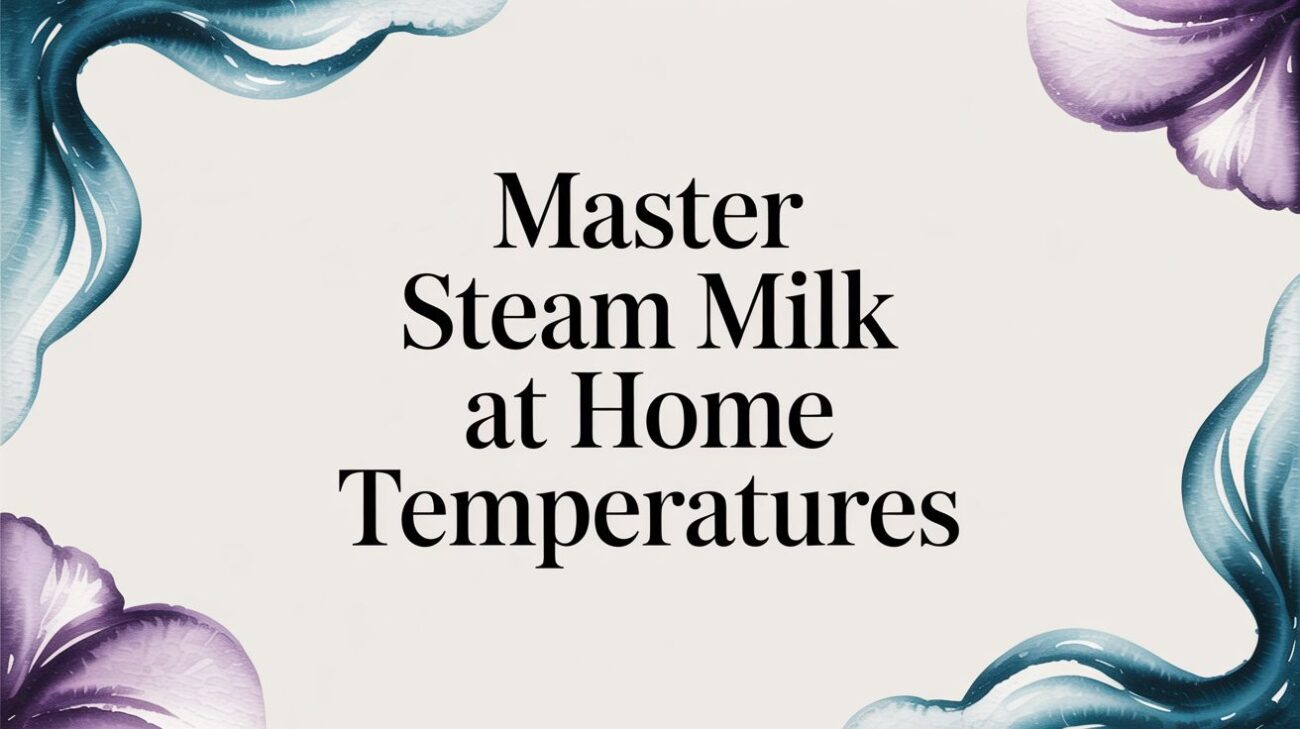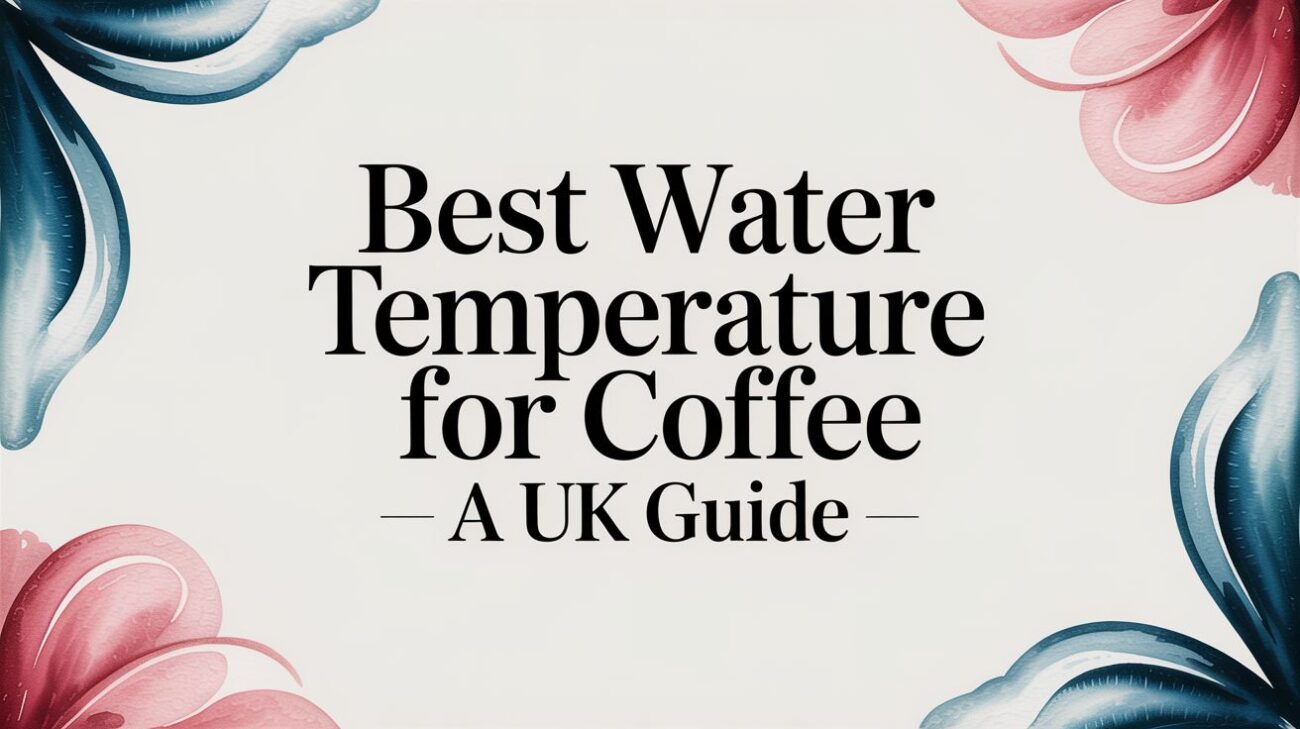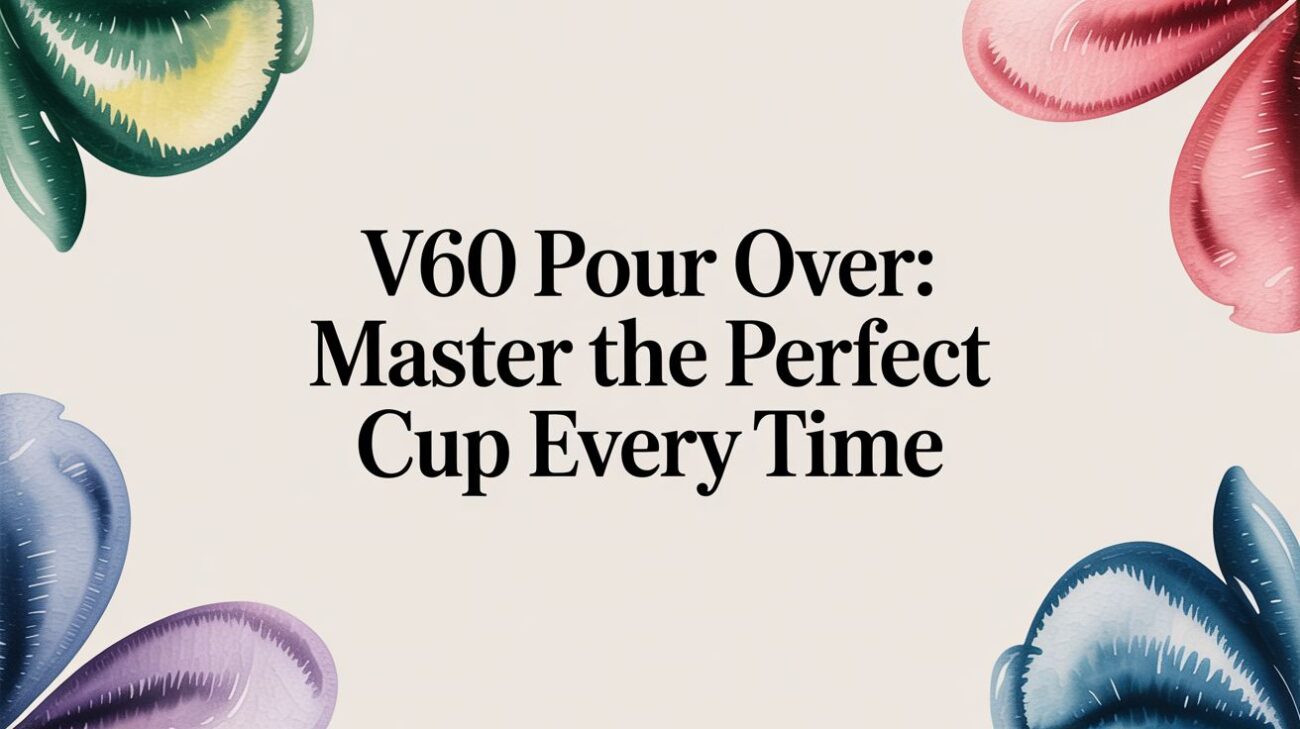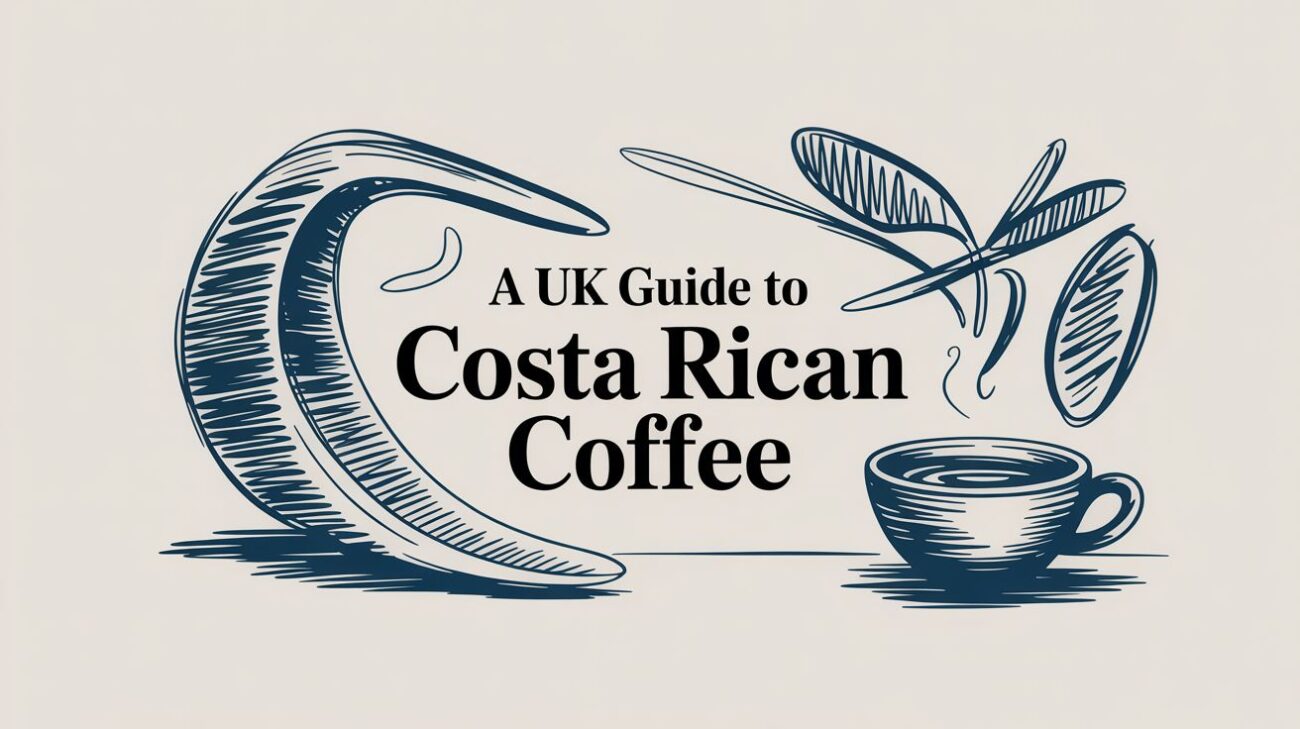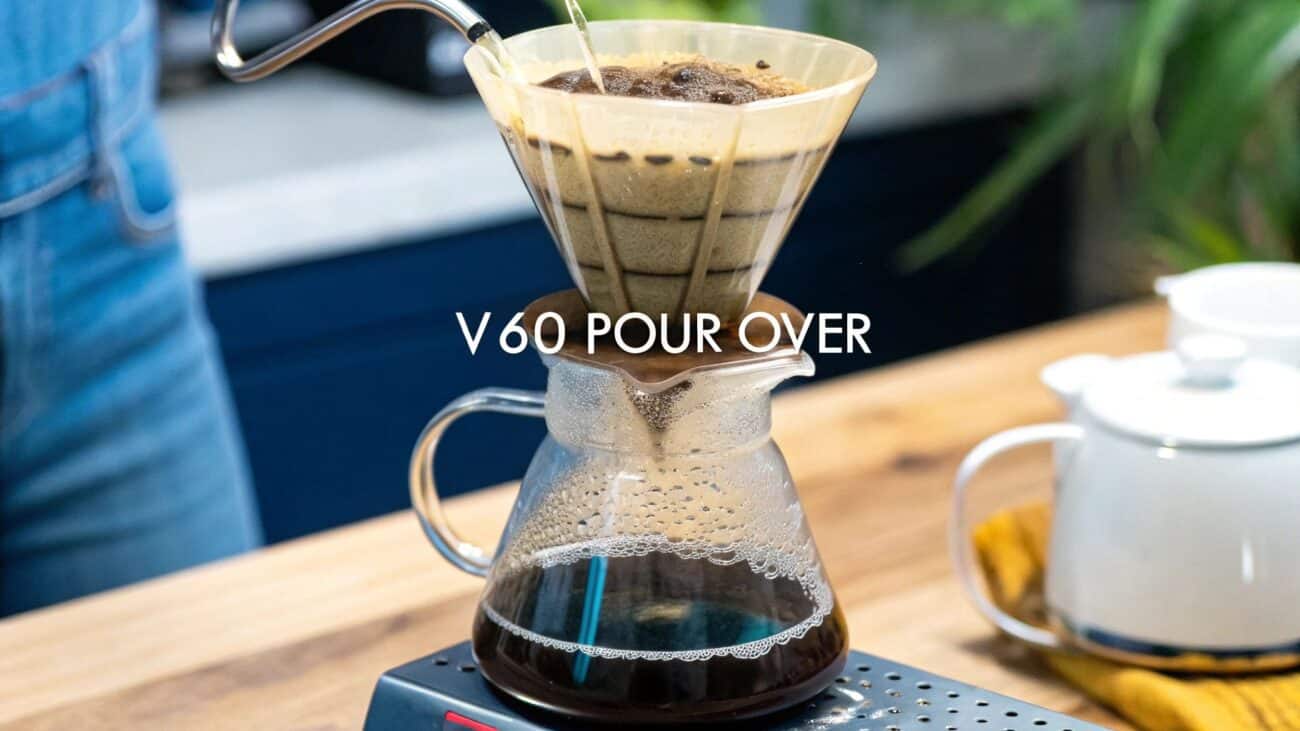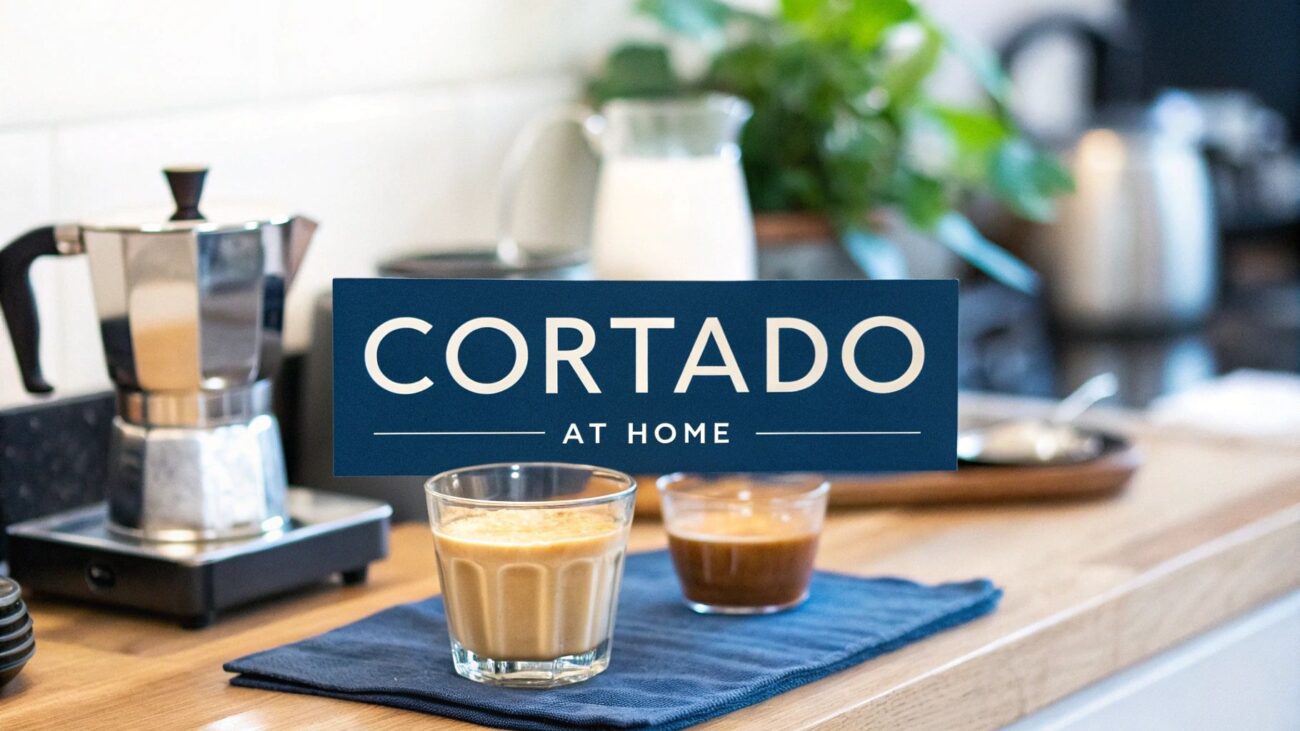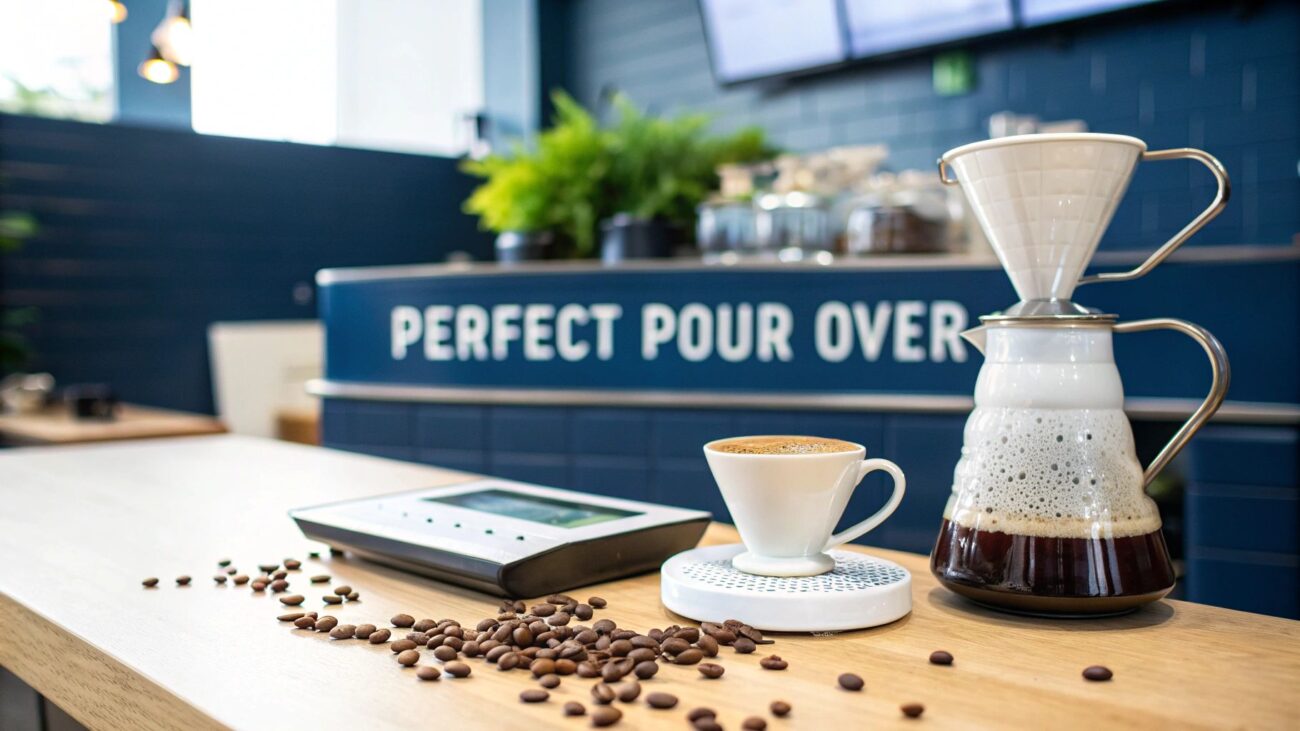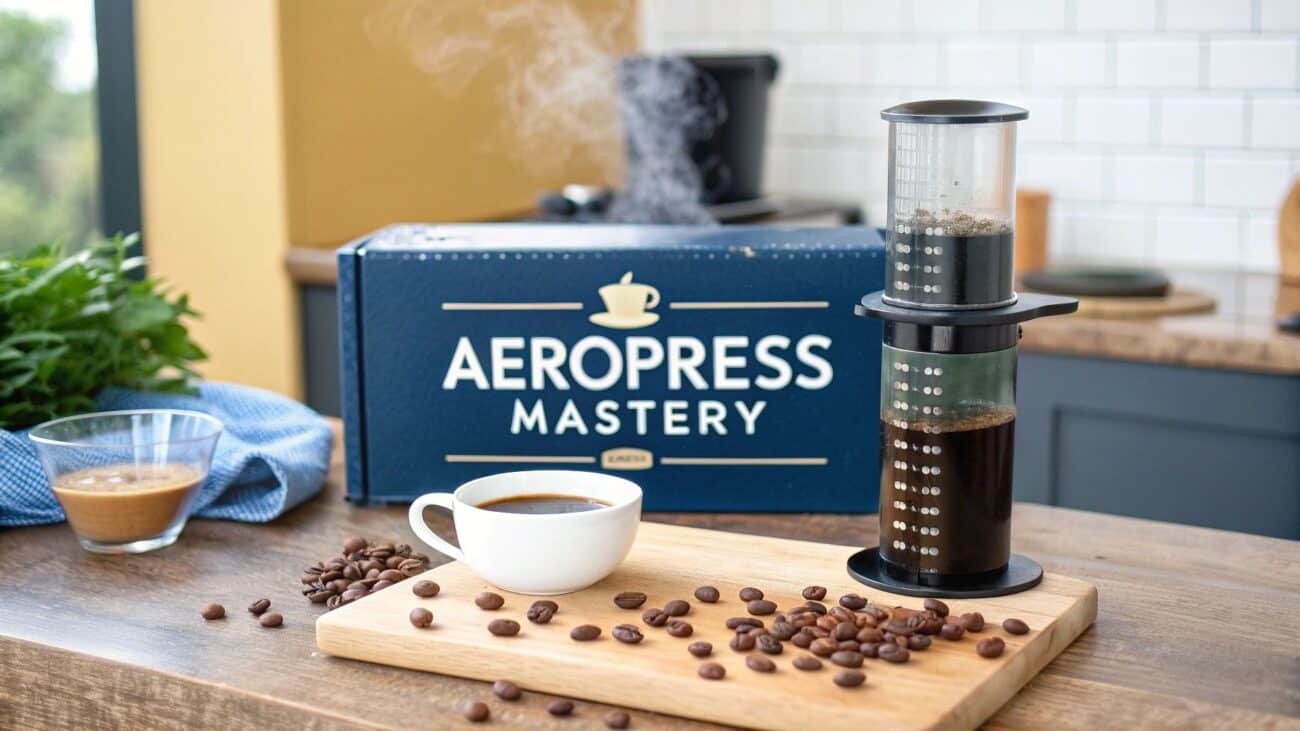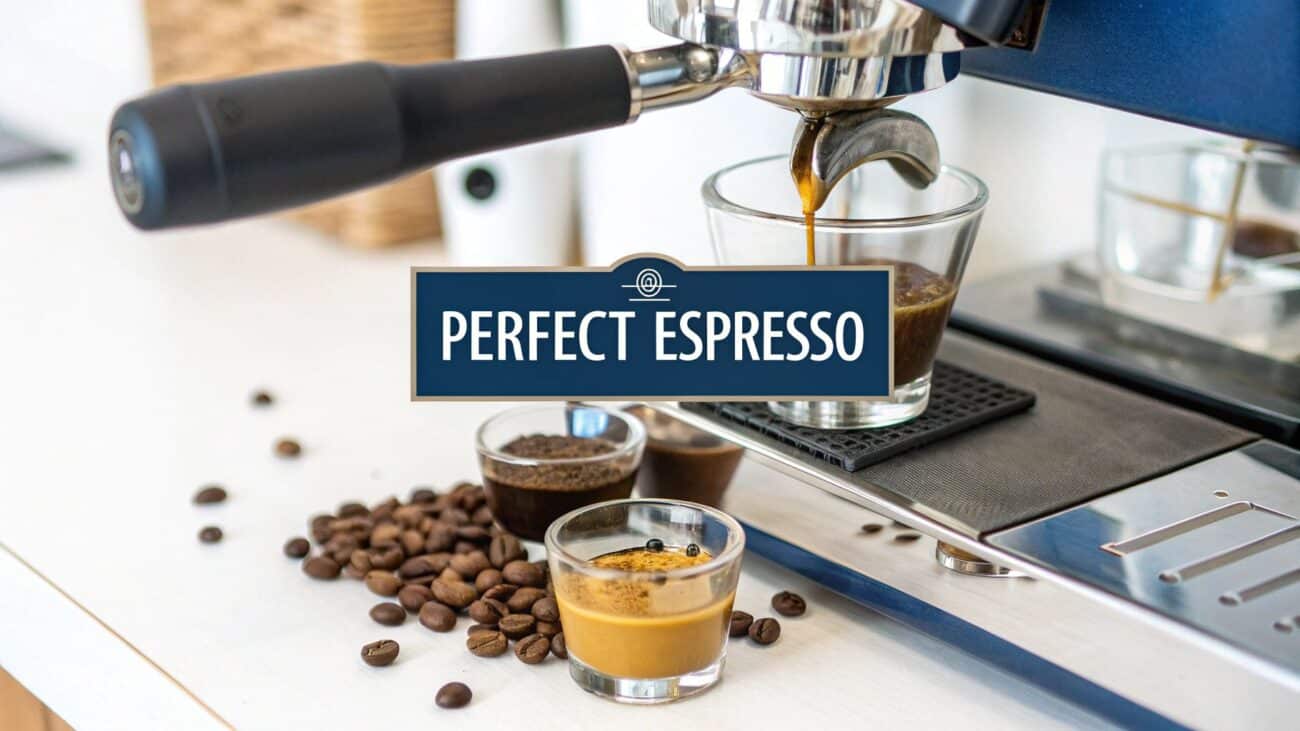Top 5 Best Coffee Brewing Methods for Perfect Home Coffee
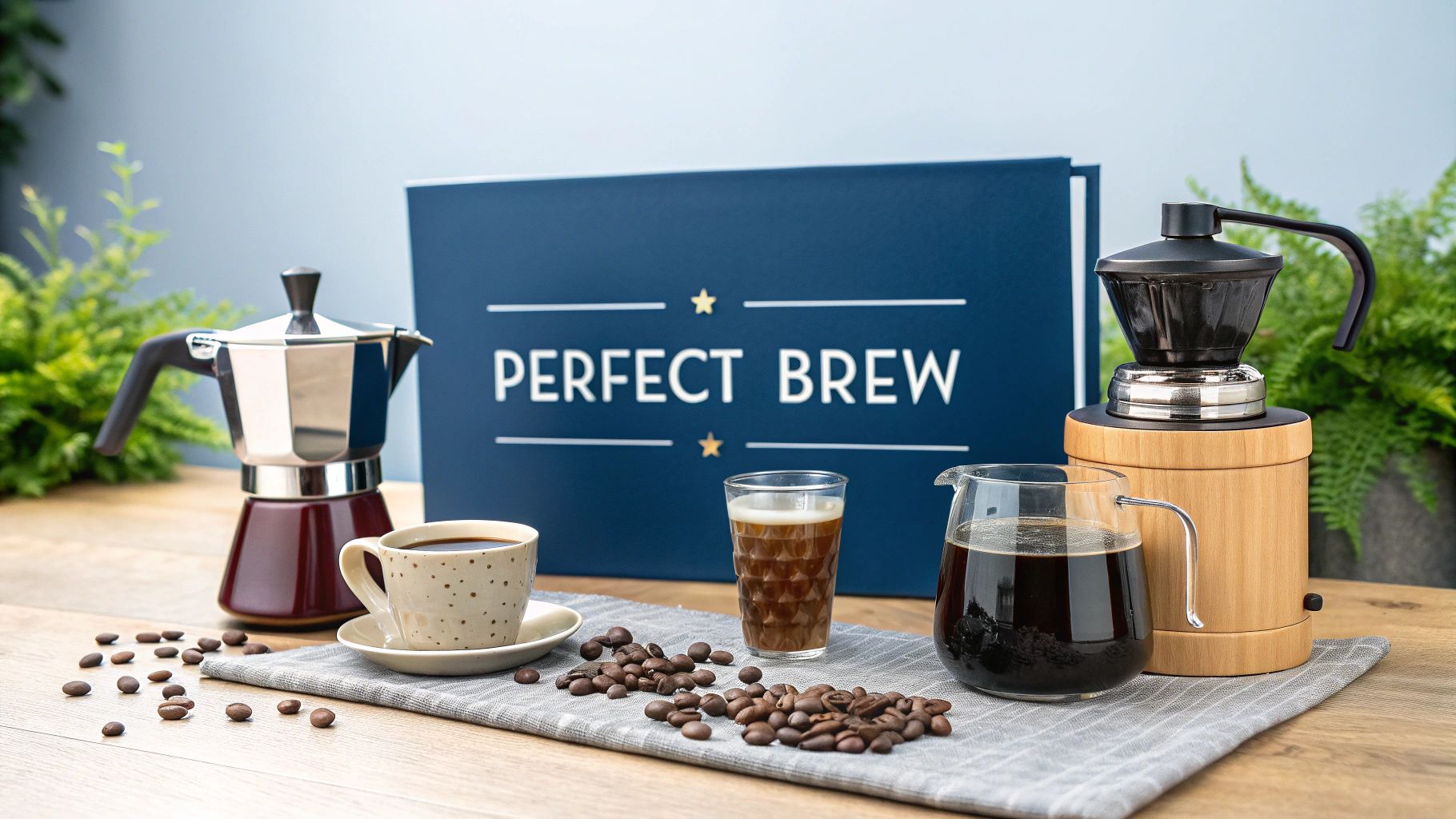
Welcome to the world of exceptional coffee, where the journey from bean to cup is an art form you can master at home. Choosing the right brewing method is the single most important decision you can make to unlock the incredible, nuanced flavours hidden within your coffee beans. The technique you select directly influences everything from the body and acidity to the aroma of your final cup. A single-origin bean prepared with a Pour Over will taste completely different from the same bean brewed in a French Press.
This guide is designed to be your definitive resource for navigating the best coffee brewing methods available. We move beyond surface-level descriptions to provide a comprehensive, practical breakdown of the most celebrated techniques. Whether you crave the clean clarity of a V60, the rich and robust body of a cafetière, or the intense shot of an espresso, understanding the specific variables of each is key.
Here, you will find a detailed exploration of today’s top methods, from the classic Moka Pot to the innovative AeroPress. For each one, we will cover:
- The essential equipment required.
- Precise grind size and water temperature recommendations.
- Step-by-step brewing instructions and ideal coffee-to-water ratios.
- A clear breakdown of the pros, cons, and resulting flavour profile.
Our goal is to provide actionable insights that empower you to elevate your daily ritual. By demystifying the process, we’ll help you find the perfect method to suit your personal taste and lifestyle, transforming your kitchen into your favourite speciality coffee house. Let’s begin the journey to your perfect brew.
1. Pour Over (V60/Chemex)
The pour over method stands as a favourite among coffee professionals and home brewers alike, celebrated for its ability to produce an exceptionally clean, nuanced, and vibrant cup. It’s a manual brewing technique where you pour hot water over coffee grounds in a filter cone. Gravity then draws the water through the grounds, extracting their soluble flavours into the vessel below.
This method’s true strength lies in the brewer’s control over every variable. From the water temperature and pouring speed to the grind size and total brew time, each element can be precisely managed. This meticulous approach is why pour over is one of the best coffee brewing methods for highlighting the delicate and complex flavour notes found in high-quality beans. Devices like the Hario V60, with its spiral ribs and large single hole, promote a fast flow rate for a bright taste, while the Chemex, known for its thick paper filters, yields an incredibly clean and sediment-free brew.
Key to a Perfect Brew
Achieving the perfect pour over requires attention to detail. The process is a ritual that rewards patience and precision with a superior cup of coffee.
- Gooseneck Kettle is Essential: Invest in a gooseneck kettle. Its long, narrow spout provides the control needed for a slow, steady, and even pour, which is critical for uniform extraction.
- Pre-wet the Filter: Always place the paper filter in your brewer and rinse it thoroughly with hot water before adding the coffee grounds. This step removes any papery taste from the filter and preheats your brewing device.
- Master the “Bloom”: Start your brew by pouring just enough water (about twice the weight of your coffee grounds) to saturate the grounds evenly. Let it sit for 30-45 seconds. This “bloom” allows trapped carbon dioxide to escape, leading to a more balanced extraction.
- Slow, Circular Pours: After the bloom, continue pouring in slow, controlled circles, starting from the centre and moving outwards. Avoid pouring directly onto the filter paper. The goal is to keep the coffee bed level and fully saturated.
To help you get started, this summary box outlines the core metrics for a classic pour over.

These figures provide a reliable starting point, but feel free to adjust them to suit your specific coffee and taste preferences. This method truly shines when you are trying to explore the unique characteristics of different beans; it is particularly well-suited for lighter roasts. If you’re keen to dive deeper into how bean origin impacts taste, you can explore the world of single-origin coffee and see why pour over is the ideal brewing method to unlock its potential.
2. French Press (Cafetière)
The French Press, or cafetière as it is often known in the UK, is an iconic immersion brewing method prized for its ability to create a rich, full-bodied, and deeply flavourful cup of coffee. The process is straightforward yet effective: coarse coffee grounds are steeped directly in hot water for several minutes. Once the steep time is complete, a plunger with a fine metal mesh filter is pressed down, separating the grounds from the brewed coffee.

Unlike methods that use paper filters, the French Press’s metal filter allows the coffee’s natural oils and some microscopic sediment (fines) to pass into the final cup. This is what gives French Press coffee its signature heavy mouthfeel, velvety texture, and robust character. Its simplicity and the unique profile it produces make it one of the best coffee brewing methods for those who enjoy a strong and hearty brew. Iconic brands like Bodum have popularised this brewer worldwide, making it a staple in countless kitchens.
Key to a Perfect Brew
A perfect French Press brew is all about mastering a few simple variables to prevent under or over-extraction, which can lead to a weak or bitter taste. Precision with your timing and grind size is paramount.
- Coarse and Uniform Grind is Crucial: Use a consistent, coarse grind, similar in texture to breadcrumbs. A grind that is too fine will pass through the mesh filter, creating a muddy, silty cup, and can also make the plunger difficult to press down.
- Time Your Steep Exactly: A four-minute steep time is the gold standard for a French Press. Set a timer as soon as you add the water. Steeping for too long will result in a bitter, over-extracted coffee.
- Press Slowly and Steadily: When your timer goes off, press the plunger down with slow, even pressure. Pushing too fast can agitate the coffee grounds, forcing fine particles through the filter and creating excess sediment in your cup.
- Serve Immediately: Do not let the coffee sit in the French Press after plunging. The grounds at the bottom will continue to extract, making the remaining coffee bitter. Decant the entire batch into a separate carafe or serve it all right away.
3. Espresso
Espresso is the heart of modern coffee culture, a concentrated and intense shot of coffee that serves as the foundation for countless beloved drinks. The method involves forcing hot water at very high pressure (typically around 9 bars) through a small puck of finely-ground, compacted coffee. This entire process happens in just 25-30 seconds, resulting in a complex, syrupy brew with a signature layer of rich, reddish-brown foam on top, known as crema.
The power of espresso lies in its unique extraction process. The high pressure and fine grind allow for a rapid and efficient extraction of oils, solids, and aromatics, creating a flavour profile that is impossible to replicate with other methods. It’s this intensity and concentrated nature that makes espresso one of the best coffee brewing methods for those who appreciate a powerful and nuanced coffee experience. From the classic Italian espresso shot to the lattes and cappuccinos that dominate coffee shop menus, it all begins here.
Key to a Perfect Brew
Pulling a great espresso shot is a science that demands precision, consistency, and a deep understanding of the variables at play. While it has a steep learning curve, mastering it is incredibly rewarding.
- Dial in Your Grind: The grind is paramount. It must be very fine, almost like powdered sugar, but not so fine that it chokes the machine. You’ll need to make tiny adjustments to your grinder to find the sweet spot where the shot extracts in the target 25-30 second window.
- Consistent Tamping is Crucial: Apply firm, even pressure when tamping the coffee grounds in the portafilter. The goal is to create a level, uniformly compacted puck so that water flows through it evenly, preventing channelling and ensuring a balanced extraction.
- Monitor Your Ratios: Precision is everything. Use a scale to measure your dose (the amount of dry coffee grounds) and your yield (the weight of the liquid espresso). A common starting point for a double shot is 18-20 grams of coffee producing 36-40 grams of espresso.
- Keep Your Equipment Spotless: An espresso machine is a complex piece of equipment. Daily cleaning of the group head, portafilter, and steam wand is non-negotiable to prevent a build-up of old coffee oils, which can impart a rancid taste to your brew.
The espresso method is particularly sensitive to the coffee beans used. The high-pressure extraction magnifies the characteristics of the bean and the roast. To understand how different roasting levels can impact your shot, you can explore how coffee roasting profiles are developed and choose the perfect beans for your taste. This method is truly a celebration of coffee in its most concentrated form.
4. AeroPress
The AeroPress has cultivated a devoted global following since its invention in 2005, and for good reason. This innovative device uses a unique hybrid brewing method, combining full immersion with air pressure. Hot water is mixed with coffee grounds in a chamber, and after a short steep, a plunger is used to press the water through a paper filter directly into a cup. This process is exceptionally fast, often taking under two minutes.
Its brilliance lies in its versatility and forgiving nature. The combination of a short brew time and the use of air pressure results in a remarkably smooth, rich, and full-bodied cup with noticeably low acidity and bitterness. This makes it one of the best coffee brewing methods for those who find other techniques too harsh. The compact, durable, and lightweight plastic design also makes it the ultimate travel companion for coffee lovers, ensuring a superb brew whether at home, in the office, or halfway up a mountain.
Key to a Perfect Brew
Achieving an excellent AeroPress brew is straightforward, but a few key techniques can elevate your coffee from good to exceptional. The device encourages experimentation, allowing you to fine-tune your recipe to perfection.
- Experiment with the Inverted Method: While the standard method is great, many enthusiasts prefer the “inverted” technique. This involves assembling the AeroPress upside down, allowing for a longer, controlled immersion without any coffee dripping through prematurely.
- Dial in Your Grind: A medium-fine grind, similar to table salt, is a fantastic starting point. However, the AeroPress works well with a wide range of grind sizes, so don’t be afraid to adjust based on your preferred brew time and flavour profile.
- Watch Your Water Temperature: Unlike other methods that require near-boiling water, the AeroPress excels with a lower temperature, typically around 80-90°C (175-195°F). This helps to prevent over-extraction and bitterness, producing a sweeter cup.
- Press Slowly and Steadily: Apply gentle, consistent pressure to the plunger. Aim for a pressing time of around 20-30 seconds. A slow press ensures even extraction and prevents fine grounds from being forced through the filter.
For those curious about this versatile brewer, you can find the AeroPress and its accessories here to start your brewing journey. It is particularly well-suited for producing a concentrated, espresso-style shot that can be diluted with water to make an Americano, or for brewing a clean, full-flavoured cup that highlights the unique notes of single-origin beans.
5. Cold Brew
Cold brew has surged in popularity, becoming a staple in coffee shops and homes for those who prefer a smoother, less acidic, and naturally sweet coffee experience. Unlike traditional methods that use heat to extract flavour, cold brew relies on time. Coarsely ground coffee is steeped in cold or room-temperature water for an extended period, typically 12 to 24 hours, before being filtered.
This gentle, slow-steep process fundamentally changes the chemical profile of the final drink. It extracts fewer of the oils and acids that can lead to bitterness and astringency, resulting in a coffee concentrate that is incredibly smooth, mellow, and often highlights the chocolatey and fruity notes of the beans. Popularised by brands like Stumptown and the historical Kyoto-style drip towers from Japan, this method is one of the best coffee brewing methods for creating a refreshing and easy-to-drink beverage that is exceptionally versatile.
Key to a Perfect Brew
Making great cold brew is more about patience than complex technique. Following a few simple guidelines will ensure a delicious and consistent result every time.
- Coarse Grind is Crucial: Use a very coarse grind, similar to the texture of breadcrumbs. A fine grind will over-extract during the long steeping time, leading to a cloudy and bitter brew that is difficult to filter properly.
- Embrace the Long Steep: Patience is paramount. A steep time of 12 to 16 hours at room temperature is the sweet spot for a balanced extraction. Steeping for too short a time will result in a weak, underdeveloped flavour, while steeping for too long can introduce woody or off-tastes.
- Filter Thoroughly: After steeping, it is vital to filter the grounds out completely. You can use a fine-mesh sieve, a French press, a cheesecloth, or a dedicated cold brew system with paper filters for an even cleaner result. This prevents any residual grit from muddying the final cup.
- Start with a Concentrate: Brew your cold brew as a concentrate, typically using a coffee-to-water ratio between 1:4 and 1:8. This creates a strong base that can be stored in the refrigerator for up to two weeks and diluted with water, milk, or tonic to your desired strength before serving.
To help you get started, this summary box outlines the core metrics for a classic cold brew concentrate.
These figures are a great starting point for creating a versatile concentrate. The beauty of cold brew lies in its forgiving nature and simple process. It’s particularly well-suited for medium to dark roasts, as it tames their bitterness and enhances their rich, deep flavours. If you enjoy a less acidic and naturally sweeter coffee, this method is an excellent choice.
6. Chemex
The Chemex is more than just a coffee maker; it’s an iconic piece of design that brews an exceptionally clean and flavourful cup. Invented in 1941 by chemist Dr. Peter Schlumbohm, its elegant hourglass vessel, wooden collar, and leather tie have earned it a permanent place in museums like the MOMA. As a pour-over method, it operates on a simple principle: hot water is poured over coffee grounds in a special filter, allowing the brewed coffee to drip into the carafe below.

What truly sets the Chemex apart is its proprietary bonded paper filters. These filters are significantly thicker than those used in other pour-over devices, removing almost all oils and sediment during the brewing process. The result is a uniquely pure, bright, and nuanced coffee with a tea-like clarity and a smooth, sediment-free body. This makes the Chemex one of the best coffee brewing methods for coffee lovers who appreciate delicate floral and fruity notes, especially in light-roast single-origin beans.
Key to a Perfect Brew
Brewing with a Chemex is a deliberate and rewarding ritual. The all-glass construction ensures no unwanted flavours interfere with your coffee, and mastering the technique unlocks a superior tasting experience.
- Use Chemex Filters: The unique, thick Chemex-branded filters are non-negotiable for achieving the classic clean cup. Ensure you fold them correctly, with the triple-layered side facing the pouring spout to prevent it from collapsing and to allow air to escape.
- Thoroughly Rinse the Filter: Due to their thickness, it’s crucial to rinse the filters with a generous amount of hot water. This step removes any paper taste and preheats the glass carafe, which is vital for maintaining a stable temperature throughout the brew.
- Opt for a Medium-Coarse Grind: A grind size resembling coarse sea salt is ideal. If the grind is too fine, the water will stall and over-extract the coffee, leading to a bitter taste. If it’s too coarse, the water will pass through too quickly, resulting in a weak, under-extracted brew.
- Maintain a Slow, Patient Pour: Just like other pour-over methods, start with a 30-45 second “bloom” to release CO2. Afterwards, continue pouring slowly in concentric circles, keeping the water level well below the top of the brewer. The entire process should take around 3.5 to 4.5 minutes.
7. Moka Pot (Bialetti)
The Moka Pot is an iconic stovetop brewer that holds a special place in the heart of Italian coffee culture. Invented by Alfonso Bialetti in 1933, this method uses steam pressure to push hot water upwards through a bed of coffee grounds, producing a rich, concentrated, and intensely aromatic brew that is often described as being somewhere between drip coffee and true espresso.
This method’s enduring appeal lies in its simplicity, speed, and the robust flavour it delivers. Unlike more delicate brewing methods, the Moka Pot is celebrated for producing a bold, full-bodied coffee with a syrupy mouthfeel. Its classic octagonal design, typically made from aluminium, is not just a coffee maker but a piece of design history found in millions of households worldwide. For those who enjoy a strong, powerful cup without the expense and complexity of an espresso machine, the Moka Pot is one of the best coffee brewing methods available.
Key to a Perfect Brew
Achieving the perfect Moka Pot brew is about managing heat and timing to avoid bitterness. This straightforward process rewards careful technique with a consistently strong and satisfying cup.
- Use a Medium-Fine Grind: Your coffee should be ground slightly coarser than espresso but finer than for drip coffee. If the grind is too fine, it can clog the filter; too coarse, and the coffee will be weak.
- Fill with Pre-heated Water: For a cleaner taste, fill the bottom chamber with hot water, just up to the safety valve. This shortens the total time the pot spends on the heat, which helps prevent the coffee grounds from getting “cooked” and developing a metallic taste.
- Don’t Tamp the Grounds: Fill the filter basket with coffee and level it off with your finger, but do not pack or tamp it down. Tamping the grounds can create too much pressure and impede the water flow.
- Gentle Heat is Key: Place the Moka Pot on a low to medium heat source. High heat can scorch the coffee, resulting in a bitter flavour. As soon as you hear a gurgling sound and see the coffee stream turn a light, honey colour, remove it from the heat immediately.
To help you get started, this summary box outlines the core metrics for a classic Moka Pot.
These figures provide a solid starting point, but the beauty of the Moka Pot is its forgiving nature. It’s an excellent choice for creating a strong coffee base for drinks like lattes or Americanos at home. If you’re intrigued by the history and cultural significance of this beloved brewer, you can learn more about the Moka Pot’s story and appreciate why it remains a global favourite.
Top 7 Coffee Brewing Methods Comparison
| Brew Method | Implementation Complexity 🔄 | Resource Requirements ⚡ | Expected Outcomes 📊 | Ideal Use Cases 💡 | Key Advantages ⭐ |
|---|---|---|---|---|---|
| Pour Over (V60/Chemex) | Medium – requires manual skill and precise pouring | Moderate – gooseneck kettle, scale, filters | Clean, bright, nuanced cup highlighting origin | Small batch, slow mornings, flavour exploration | Full control, consistent high quality, inexpensive equipment |
| French Press (Cafetière) | Low – simple steep and press process | Low – French Press, burr grinder | Full-bodied, rich, oily, with sediment | Multiple cups, casual/home, easy brewing | Inexpensive, durable, great for groups, no filter cost |
| Espresso | High – precise variables, pressure extraction | High – espresso machine, grinder, maintenance | Intense, concentrated, crema-topped shot | Quick shots, base for specialty drinks | Fast brew, complex flavours, professional standard |
| AeroPress | Low to Medium – simple but allows experimentation | Low – AeroPress device, filters | Clean, smooth, low-acid coffee | Portable brewing, travel, single cup quick brew | Versatile, fast, durable, easy cleanup |
| Cold Brew | Low – very simple but long steeping time | Low – jar/filter, coarse grinder | Smooth, low acidity concentrate | Large batches, summer/iced coffee | Long shelf life, batch brewing, low bitterness |
| Chemex | Medium – manual pour-over with specialty filters | Moderate – Chemex, proprietary filters, gooseneck kettle | Exceptionally clean, bright, clear cup | Entertaining, design-focused brewing | Iconic design, exceptional clarity, easy to clean |
| Moka Pot (Bialetti) | Low to Medium – stovetop use, less control | Low – Moka Pot, medium-fine grinder | Strong, concentrated, less intense than espresso | Stovetop use, camping, authentic Italian coffee | Inexpensive, portable, no electricity needed |
Brew Your Best Cup with Seven Sisters Coffee
Our journey through the world’s best coffee brewing methods has taken us from the clean, nuanced notes of a Pour Over to the bold, immersive depths of a French Press. We have explored the intense concentration of Espresso, the versatile clarity of the AeroPress, the smooth, low-acidity of Cold Brew, the elegant purity of the Chemex, and the rich, stovetop tradition of the Moka Pot. It is clear that there is no single “best” method, only the best method for you, your palate, and your daily routine.
The true takeaway is that control, consistency, and curiosity are your greatest assets. The ideal brew is not a static destination but a dynamic process of discovery. By understanding the core variables – grind size, water temperature, brew ratio, and extraction time – you empower yourself to move beyond simply following a recipe and begin crafting a cup that is uniquely yours. This guide serves as your map, but your senses are the compass.
Finding Your Perfect Brewing Partner
Reflecting on the methods we have covered, consider which one aligns most closely with your coffee-drinking priorities.
- For the Ritualist: If you savour the process as much as the result, the meticulous, hands-on nature of a V60 or Chemex offers a meditative and rewarding experience. The control over every variable allows you to chase the perfect expression of a single-origin bean.
- For the Pragmatist: If you seek a balance of flavour, convenience, and versatility, the AeroPress is an unmatched companion. Its speed, portability, and forgiving nature make it ideal for both home use and travel.
- For the Traditionalist: If you crave a rich, full-bodied, and comforting cup, the French Press (Cafetière) provides a classic, immersive brew that is both simple and deeply satisfying.
- For the Bold Enthusiast: If you desire intensity and a concentrated coffee experience, mastering the Espresso machine or the Moka Pot will unlock a world of powerful flavours and the foundation for countless milk-based drinks.
Your brewing equipment is an instrument, and the coffee beans are the sheet music. To create a beautiful symphony of flavour, both must be of the highest quality. The best coffee brewing methods can only realise their full potential when paired with exceptional, freshly roasted beans.
The Most Important Ingredient: The Coffee
Ultimately, the ceiling for your coffee’s quality is determined not by the brewer, but by the beans themselves. An old, poorly roasted, or low-grade bean will produce a disappointing cup, no matter how precise your technique with a Chemex or how powerful your espresso machine is. Conversely, an exceptional, freshly roasted coffee can shine even with the simplest of methods.
This is where the journey truly begins. Experimenting with different origins, processing methods, and roast profiles will transform your understanding and appreciation of coffee. Notice how a naturally processed Ethiopian bean presents vibrant, fruity notes in an AeroPress, while a washed Colombian bean offers clean, chocolatey tones in a French Press. Mastering your chosen brewing method is about learning how to best translate the story that is already inside the bean. It is about honouring the hard work of the farmers and the skill of the roaster by extracting the most delicious and authentic flavours possible. Every cup is an opportunity to connect with a specific place and a specific process, turning a simple morning routine into a global tasting experience.
The perfect bean is the starting point for every great cup of coffee. At Seven Sisters Coffee Co, we meticulously source and roast our coffee using an innovative oxygen-free process, preserving the delicate and complex flavours inherent in each origin. Our commitment to quality ensures that whichever of the best coffee brewing methods you choose, our beans will provide the perfect foundation for a truly exceptional brew.

